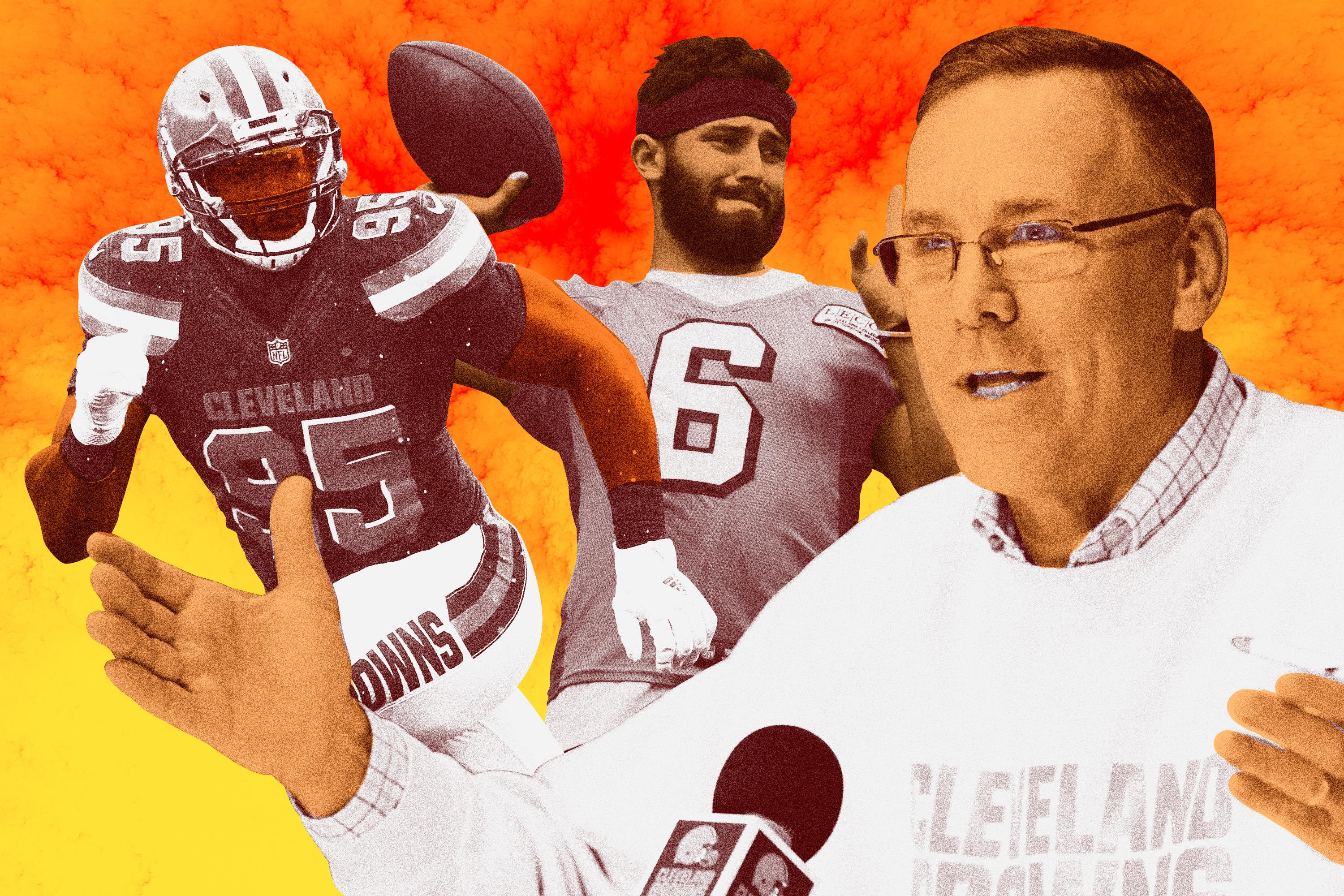
I was halfway through my question when John Dorsey put up three fingers: “For a real rebuild, you’ve got to have patience, and it’s going to take about three years.”
Dorsey is the sixth Browns general manager since 2009. None of his predecessors lasted for more than three years.
Despite going 0-16 last season and 1-15 the year before, Cleveland might be in a better position than at any prior point during its near-decade-long rebuild. At the very least, the Browns are more interesting than they have been in years past. The Browns entered the spring with $110 million in cap space and a truckload of draft picks, and they pulled off a number of high-profile trades: Tyrod Taylor for a third-round pick, Jarvis Landry for fourth- and seventh-rounders, Damarious Randall for DeShone Kizer and a pair of pick swaps. They took Baker Mayfield, as exciting a quarterback prospect as there’s been in years, with the first overall pick. And even after all that, Dorsey was quick to point out, they still led the league in cap space.
There are still dozens of outstanding questions: When will Mayfield start? Which of their young players can take the leap? Is Hue Jackson the long-term coach? And then there’s the overarching concern that’s been looming over Cleveland for 20 years since the franchise’s rebirth: When will the Cleveland Browns be genuinely good?
Last December, the Browns fired executive vice president of football operations Sashi Brown after a two-year run that can be described as a sort of low-grade football version of the Process, based on analytics and the longest possible long game. Brown’s Browns made forward-thinking, value-accruing moves like taking on Brock Osweiler’s undesirable contract just to snag a second-round pick, hoarding draft picks, and drafting an elite athlete like Myles Garrett with the first overall pick. In that time, they also passed on drafting a handful of quarterbacks, most notably Carson Wentz and Deshaun Watson, who would have been an improvement on, say, Kizer or Cody Kessler or any of the quarterbacks who played for Cleveland over the past two years. And so Brown was out, and Dorsey, fired by Kansas City after overseeing a 43-21 record in his four years in charge, was in.
“Those guys did a nice job in terms of acquiring the cap space. They hurt themselves in that they got too young,” Dorsey said, adding that he likes Brown. The former executive’s full-scale rebuild was rare among NFL teams, which typically try to retool on the fly in the parity-filled league. Dorsey wants the team to remain young, but not too young. As he put it: “That’s the plan I always wanted to do—top five youngest in the league, not the youngest.”
Dorsey also thinks trades are a significantly more valuable team-building vehicle than signing free agents. Terrible teams have to overpay in free agency to convince players to play for them, and all general managers know this. That’s why Dorsey wanted to trade for a handful of veterans—in this case, Taylor, Randall, and Landry—so that players and agents knew before free agency that the Browns would be competitive. “You wipe off the stigma a little bit so all of the sudden, [free-agent] guys are actually excited and you don’t have to overspend.” This haul of free agents includes tackle Chris Hubbard, who signed from Pittsburgh for five years and $36.5 million; T.J. Carrie, a cornerback from Oakland; running back Carlos Hyde, who’ll make $5 million a year for three years; and cornerback E.J. Gaines from Buffalo. Mychal Kendricks, a Super Bowl champion with the Eagles, signed for one year and $2.25 million. Packers role player Jeff Janis is in for $1.25 million.
“I wasn’t going to blow up the cap because guess what: We still have the most cap space in the National Football League. I think we prudently addressed the team in a very selective fashion, without spending crazy and going out,” Dorsey said. “Realistically, in free agency, nine times out of 10 you’re not getting what you pay for.” He didn’t think there was enough competition at every position on the team and so he added at least a piece to each position.
Dorsey is fascinated with modern spending habits of NFL teams. He’s asked his research team to compile a database of each team’s 10 most expensive salaries so he can study how a team with top-heavy salaries operates vs. one with a more balanced approach. He said that the “art of balancing the salary cap is what it’s all about” in the modern NFL, noting that the rising cap has created flexibility for many teams, but has also led to inflated contracts for many players around the league.
There’s a plan at quarterback in Cleveland, and that’s more than you can say of previous years. Plus, the plan seems like a sound one.
“I just want to see Tyrod do what he’s done in the past. He’s a natural born leader. He’s had an excellent camp so far. I want to see it unfold. There may come a point here where I call his representatives in October and say, ‘Let’s strike something up,’” Dorsey said about a potential extension for Taylor, who has just one year left on his deal. I asked whether it would be a disappointment if they have to look at Taylor long term, which would imply that Mayfield wasn’t pushing him as the starter. “Nah, let’s deal with it when it happens,” he said.
Dorsey wanted an established veteran (Taylor), then a second quarterback (Drew Stanton) who understood his role and could both help the starter game plan on Monday and Tuesday and help the rookie quarterback (Mayfield) develop. While Taylor will be the starter, Dorsey also raved about Mayfield’s quick release.
Despite overhauling nearly every position group, the Browns do have pieces to build around. Defensive lineman Larry Ogunjobi (24 years old) played well last year. Running back Duke Johnson (24) had nearly 700 receiving yards. Josh Gordon, still only 27, is one of the most talented players in the league. Brown, who has been lauded for his drafting ability, assembled a nice chunk of talent that simply failed to win games.
Despite Brown’s departure, the analytics era in Cleveland is not dead. Dorsey used it in Kansas City—particularly athletic testing numbers—and has met routinely with the staff assembled by chief strategy officer Paul DePodesta of Moneyball fame. “You can pigeonhole me as a football guy but I’m smart enough to realize that in the 21st century, you can get measurements off of mathematics—absolutes—and the concepts are valid,” Dorsey said. “I’m going to look at everything because it creates broader thinking. … Paul and his staff, there’s validity to the stuff that they bring. Part of making good decisions is having as much information as you can.” He’s excited about player-tracking data, which will monitor the movement of players on the field and will be shared league-wide this year for the first time. Mayfield, if not a purely analytical pick, is a forward-thinking one. Listed at 6-foot-1, he lacks the size most NFL general managers demand in their franchise quarterback, and he came from an offense at Oklahoma that only an innovative NFL team could utilize in the pros.
Dorsey’s view of analytics—that it should be blended in with traditional scouting methods—is the prevailing view around the league. Most teams now have an analytics department. I’ve spoken with a handful of coaches this month who said they had embraced the movement more in the past year, particularly as younger coaches and executives have begun to populate the league’s top jobs. Dorsey’s timetable for competing is more in line with traditional NFL norms as well—I’ve long argued that a full teardown is a tough strategy in the NFL, where contracts and careers are significantly shorter than in the NBA or baseball.
Dorsey thinks that for 2018, the team has the right balance of youth and veterans, and he’s trying to build on both. He mentioned Garrett’s athleticism and that he loves sending him video of top pass rushers. When he mentioned Arizona’s Chandler Jones as an elite pass rusher, I told him there was footage going around of Jones breaking a sled in practice earlier in the day. “What is he doing? Is he doing MMA stuff? How do you break a sled?” He was more excited, though, for the motivational ammo it could provide. As he pulled up the video on his phone, he said, “I’m going to send this to Myles Garrett and tell him he can’t do this.”
After practice that same day, Dorsey called Jarvis Landry over and told him that when he’s working on the Jugs machine with his fellow receivers, they should grab each others’ arms before the catch to simulate a contested reception. “If that’s what you want,” Landry said, “we’re doing it.”
Dorsey compared this team to two of his previous teams—the 1992 Packers, where he was a scout, and the 2013 Chiefs, where he was general manager. That Packers team improved to 9-7 from 4-12, and the Chiefs team went to 11-5 from 2-14 the previous year. He was short on specific predictions for this year, just saying that he thinks the team will be competitive every week.
I asked him whether, with all of that cap space, there’s a Jaguarsesque spending spree in the team’s future to collect talented players and speed up the rebuild. He said there isn’t and that the Browns are saving a chunk of cap space for the looming possibility of lucrative extensions for homegrown players. “I have to look down the road three years,” Dorsey said. “I’ve always told the players this: If you play well, we’re gonna talk about an extension for you. I have to take care of those guys, because they’ve been in the system. You reward your own guys first.”
So the long—but not too long—game begins in Cleveland. With the upgrades, the Browns are certain to be, uh, better than the 1-31 record they’ve had the past two years, though that’s hardly the point. Rather, the point is in the future.
“It takes around three years, but you want to build every year, get a little bit better,” he said. “But you have to think long term. Every decision should include thinking three years out. If you’re making a decision now, you’re thinking of 2019, 2020. In 2019, we’ll be thinking of 2021. The equation is balancing everything out.”
